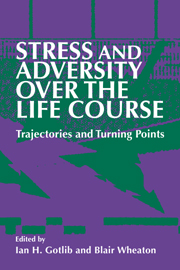Book contents
- Frontmatter
- Contents
- List of contributors
- 1 Trajectories and turning points over the life course: concepts and themes
- I Trajectories: long-term effects of adverse experience
- 2 Childhood adversity and adult psychopathology
- 3 The impact of twenty childhood and adult traumatic stressors on the risk of psychiatric disorder
- 4 Intergenerational sanction sequences and trajectories of street-crime amplification
- 5 School-leavers' self-esteem and unemployment: turning point or a station on a trajectory?
- 6 Intergenerational consequences of social stressors: effects of occupational and family conditions on young mothers and their children
- 7 Women's roles and resilience: trajectories of advantage or turning points?
- II Turning points: changes in life trajectories
- III New methods for the study of the life course
- Index
7 - Women's roles and resilience: trajectories of advantage or turning points?
from I - Trajectories: long-term effects of adverse experience
Published online by Cambridge University Press: 23 October 2009
- Frontmatter
- Contents
- List of contributors
- 1 Trajectories and turning points over the life course: concepts and themes
- I Trajectories: long-term effects of adverse experience
- 2 Childhood adversity and adult psychopathology
- 3 The impact of twenty childhood and adult traumatic stressors on the risk of psychiatric disorder
- 4 Intergenerational sanction sequences and trajectories of street-crime amplification
- 5 School-leavers' self-esteem and unemployment: turning point or a station on a trajectory?
- 6 Intergenerational consequences of social stressors: effects of occupational and family conditions on young mothers and their children
- 7 Women's roles and resilience: trajectories of advantage or turning points?
- II Turning points: changes in life trajectories
- III New methods for the study of the life course
- Index
Summary
A key component of healthy development over the life course is the cultivation and maintenance of psychosocial resilience. In this chapter I draw on a life-course approach to consider pathways to resilience in the later years of adulthood,in terms of a sense of competency and esteem on the one hand and of connectedness to the broader community on the other. As an illustrative empirical example of life-course analysis I examine women's lives, drawing on panel data collected at two points in time, 30 years apart.
The nature of resilience
“Resilience” and “protective factors” are the counterparts to “vulnerability”and “risk factors,” connoting successful adaptation to challenges and adversity(Werner 1990). Although resilience has typically been used to refer to psychological attributes of the individual, the protective factors promoting such resilience encompass social as well as psychological elements. Research and theory in the areas of stress and developmental psychopathology depict two sets of protective factors promoting resilience in the face of life's adversities: social resources and personal resources (Rutter 1987; Schaefer & Moos 1992). Social resourcespertain to social integration or connectedness in the form of occupying multiple roles, the presence of a confidant relationship, good relationships with family and friends, and access to support networks. Personal resources encompass subjective dispositions such as self-esteem, mastery, a positive outlook,self-understanding, empathy, altruism, maturity, and basic values and priorities.Both personal and social resources can be termed psychosocial resources or, alternatively, coping resources.
- Type
- Chapter
- Information
- Stress and Adversity over the Life CourseTrajectories and Turning Points, pp. 133 - 156Publisher: Cambridge University PressPrint publication year: 1997
- 16
- Cited by



